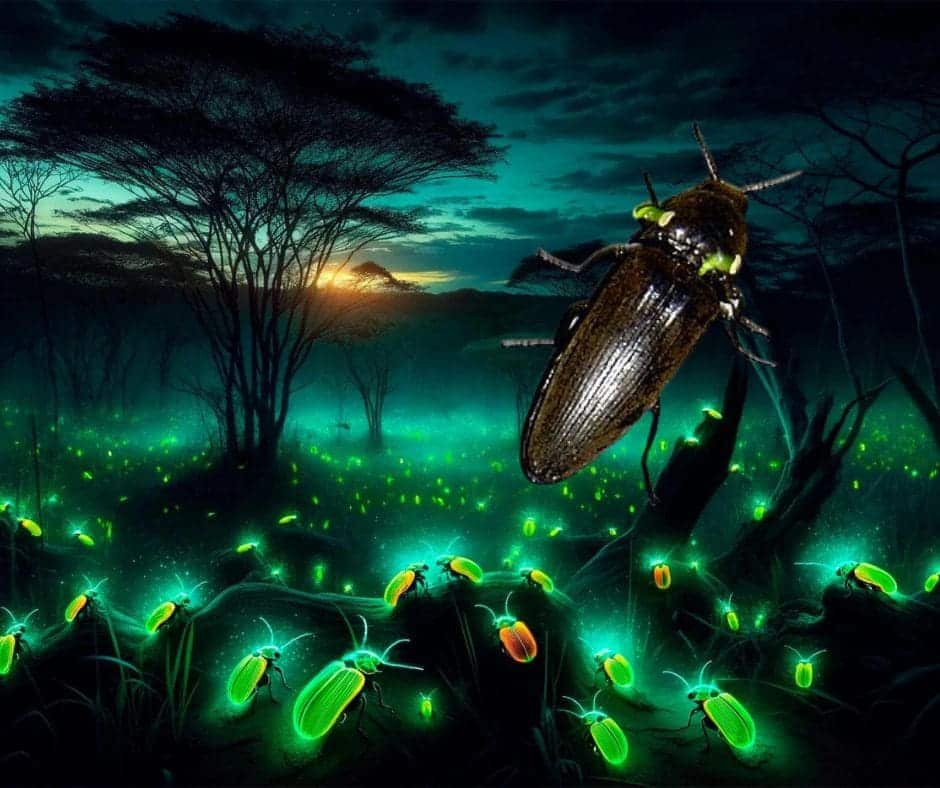In the dense, dew-soaked rainforests of Costa Rica’s Tortuguero, a tiny creature wields a light show that rivals the starlit sky. The Tortuguero beetle, a master of the dark, illuminates its nocturnal realm with a spectacular bioluminescent display. This marvel of nature, not only captivates those lucky enough to witness it but also plays a pivotal role in the ecological ballet of the forest.
Illuminating the Night: The Tortuguero Beetle’s Bioluminescent Magic
As twilight deepens in Tortuguero, a constellation of tiny lights begins to flicker at the forest floor. These are not fallen stars but the glow of the Tortuguero beetles, engaging in their nightly routines. The secret to their glow lies in their abdomen, where a chemical reaction involving a substance called luciferin and the enzyme luciferase produces a cold light. This light can be green, blue, or yellow and serves two main purposes: defense and mating.
Predators that might be tempted by a small, seemingly easy meal are often deterred by the sudden burst of light, mistaking it for larger or more dangerous prey. Meanwhile, the luminous display also signals the beetle’s presence to potential mates in a brilliant assertion of identity and virility.
A Beacon in the Dark: Mating and Defense Mechanisms
During mating season, the forest floor in Tortuguero transforms into a bustling hub of beetle activity. Male beetles amplify their glow, pulsating their lights in unique patterns to attract females. This bioluminescent communication ensures that the species continues to thrive despite the darkness that envelops their habitat.
For those wandering the paths of Tortuguero National Park at night, the sight of these glowing beetles offers a magical insight into the complexity of life adapted to the nocturnal niche. Guided night tours are available, allowing visitors to experience this enchanting phenomenon safely and respectfully, guided by experts who can point out not just the beetles but other nocturnal creatures as well.
The Environmental Symphony: Contributions to the Ecosystem
The role of the Tortuguero beetle extends beyond just beauty and biological intrigue. As part of the forest’s decomposer community, these beetles help break down detritus, facilitating nutrient recycling in the tropical ecosystem. Their bioluminescent glow also attracts curious predators, contributing to the complex food web that sustains the dense rainforest.
Researchers study these beetles not only for their ecological role but also for the potential applications of their bioluminescent chemicals in science and medicine. From tracking the spread of cancer cells to monitoring bacterial contamination, the biochemical pathways that light up our little beetle could one day illuminate new paths in human health and wellbeing.
When and Where to Witness the Glow
The best time to see the Tortuguero beetles in action is during the rainy season, from May to November when the nights are darkest and the forest is most alive. The Tortuguero National Park provides the perfect backdrop, with its protected canals and dense rainforest offering an ideal environment for the beetles’ light shows.
Visitors are advised to join guided night tours for the best chances of witnessing these creatures. Not only does this ensure a higher likelihood of sightings, but it also supports eco-tourism practices that help preserve the delicate balance of Tortuguero’s ecosystem.
Wrapping Up the Night’s Tale
The glow of the Tortuguero beetle is more than just a beautiful spectacle; it’s a testament to the adaptability and intricacy of life in one of the world’s most vibrant ecosystems. As night falls on the forests of Costa Rica, these beetles continue to play their part in the silent symphony of nature, proving that even the smallest creatures can hold the most wondrous secrets.






